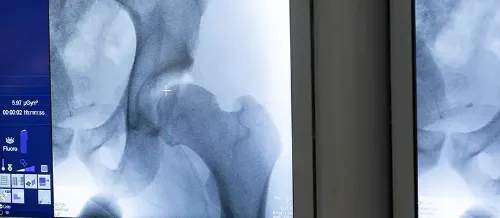Arthrosis of the hip
"The placement of a hip prosthesis is an important intervention, but nowadays it is done routinely and with great guarantee in terms of results".
DR. PABLO DÍAZ DE RADA
SPECIALIST. ORTHOPEDIC SURGERY AND TRAUMATOLOGY DEPARTMENT

The hip joint is formed by the union between the pelvic bones and the femur. In the portion of the femur that meets the pelvis, the femur is shaped like a sphere that is called the head of the femur. This sphere of the femur fits into a hole that exists in the pelvis, in such a way that a perfect gear is formed that allows the movement of the femur in many directions.
Both the head of the femur and the hollow of the pelvis in which it is articulated are covered with cartilage, which is the tissue that facilitates movement between the bones and prevents them from directly rubbing bone against bone.
Over the years, as a result of the progressive wear and tear of these cartilages, they lose their thickness and texture and even disappear.
This gives rise to the loss of the correct gear between the femur and the pelvis, which is precisely what produces the symptoms of osteoarthritis of the hip.

What are the symptoms of osteoarthritis of the hip?
Like osteoarthritis in other locations, the main symptom of osteoarthritis of the hip is pain.
The pain in the arthritis of hip is located fundamentally in the region of the groin.
Sometimes, the location of this pain can be extended and the patient also notices discomfort in the anterior aspect of the thigh, which even reaches the knee, and pain can also be noticed in the buttock.
The most common symptoms are:
- Pain in the groin or radiating to the leg.
- Morning stiffness.
- Problems when walking.
The arthritis of hip is a chronic disease, that is to say, that lasts all the life. It usually progresses very slowly, over the course of years.
Patients with hip osteoarthritis may be limited in their daily activities to a greater extent than patients whose osteoarthritis affects other, less important joints.
Do you have any of these symptoms?
You may have osteoarthritis in the hip
What are the causes of osteoarthritis of the hip?
The causes of coxofemoral osteoarthritis or hip osteoarthritis can be grouped into four categories:
- Traumatic factors: Due to injuries or illnesses that have not been cured properly, for example a dislocation.
- Vascular factors: These causes give rise to dislocations and other vascular-type damage that can trigger osteoarthritis of the hip. An example of this is Perthes disease, which is the deformity of the femoral head and osteoarthritis due to vascular insufficiency.
- Congenital factors: For the developmental disorder of the fetus, for example in a hip dysplasia or for a growth disorder (Perthes disease in children).
- Imbalance: For example caused by a dysmetry or unequal length of the lower limbs.
Preventive measures
It is advisable:
- Get the ideal weight according to your age and constitution.
- Take frequent walks with some period of rest.
- To make movements without resistance of the hip and without pain.
- Practice swimming and/or cycling without resistance.
You will avoid it as much as possible:
- Standing still for long periods of time.
- Carrying weights.
- Sitting in low and soft places for a long time.
- Self-medicating without the advice of your specialist.
How is osteoarthritis of the hip diagnosed?

The diagnosis is based on the doctor's questioning of the patient about the type of symptoms he or she is suffering from and their characteristics, followed by an examination of the hip joint, with its movements.
By means of the exploration, the doctor can objectify the degree of arthrosis that exists. To confirm the diagnosis it is necessary to carry out a radiography of the hip.
In her, the typical changes that produce the arthritis in the articulation can be seen and a prognosis can be established on the gravity of the same one, based on that the hip is more or less worn out.
How is osteoarthritis of the hip treated?
The aim of treatment is to relieve pain and maintain functional capacity
It is very important that obese patients undergo a proper slimming diet, in order to avoid the overload that overweight places on the joint.
Sometimes the use of a walking stick can be very beneficial in relieving joint pain.
Finally, and as a final resource, osteoarthritis of the hip can be operated on. The surgical intervention is indicated in those patients that suffer a very advanced arthritis, in which a very important limitation exists to walk or to carry out their daily activities.
The intervention consists of replacing the damaged joint with a hip prosthesis. After a rehabilitation program after the intervention, the patients recover and notice the disappearance of the symptoms, being able to walk and to make a practically normal life.
Where do we treat it?
IN NAVARRE AND MADRID
The Department of Orthopedic Surgery and Traumatology
of the Clínica Universidad de Navarra
The Department of Orthopedic Surgery and Traumatology covers the full spectrum of congenital or acquired conditions of the musculoskeletal system including trauma and its aftermath.
Since 1986, the Clinica Universidad de Navarra has had an excellent bank of osteotendinous tissue for bone grafting and offers the best therapeutic alternatives.
Organized in care units
- Hip and knee.
- Spine.
- Upper extremity.
- Pediatric orthopedics.
- Ankle and foot.
- Musculoskeletal tumors.

Why at the Clinica?
- Experts in arthroscopic surgery.
- Highly qualified professionals who perform pioneering techniques to solve traumatological injuries.
- One of the centers with the most experience in bone tumors.



















